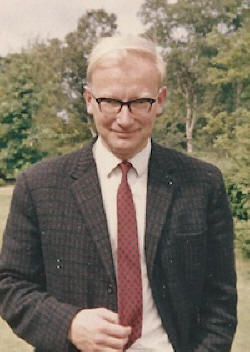

Queer Places:
University of Cambridge, 4 Mill Ln, Cambridge CB2 1RZ
5 Cornelia Ave, Mill Valley, CA 94941
 Keith
B. Wedmore was born on 16 April, 1932 in Orpington, Kent to Basil and Hilda. His father worked as an electrical engineer; his mother at anything going including fire watching during the War, but started out as a bank teller. The family went to the U.S. in September 1942. Basil was already there; his services as ships' radar repairer were so in demand that when he insisted his family come over to join him, they were shipped over. The journey was a memorable eighteen days. This was the worst month in the whole war for shipping losses: ten ships, a third of the convey, were sunk and also a frigate. At ten, Wedmore much enjoyed the whole thing. All three of them finished up on the Isle of Palms off Charleston, South Carolina.
Keith
B. Wedmore was born on 16 April, 1932 in Orpington, Kent to Basil and Hilda. His father worked as an electrical engineer; his mother at anything going including fire watching during the War, but started out as a bank teller. The family went to the U.S. in September 1942. Basil was already there; his services as ships' radar repairer were so in demand that when he insisted his family come over to join him, they were shipped over. The journey was a memorable eighteen days. This was the worst month in the whole war for shipping losses: ten ships, a third of the convey, were sunk and also a frigate. At ten, Wedmore much enjoyed the whole thing. All three of them finished up on the Isle of Palms off Charleston, South Carolina.
The family returned to the UK in 1944 just before the flying bombs (V-1s) began from German-occupied Holland. In June 1944, one came down on Keith, certain to kill him, but at 200 yards struck a barrage balloon wire which blew it up--an experience he never forgot. In England he went to grammar schools where he recalls being attracted to other boys. He then went to Jesus College, Cambridge. The lack of any decent student mental health service amazed him and he attributes this as one of the reasons that the gay Roger Walker committed suicide--an event which was to lead later to the founding of the Towards a Quaker View of Sex group.
The family can trace its Quaker roots back to 1744 when an ancestor, Catherine Mylbourne, left the Church of England for the Society of Friends. Wedmore’s father was a member of the Golders Green Meeting, but rarely attended. Keith, on the other hand, became an active Quaker in his teen years. He attended the North Finchley Meeting in London from 1947-51.
While at Cambridge Keith was with the Cambridge Young Friends who gathered on Sunday nights in the home of a prominent Quaker, Anna Bidder. She was a zoologist on the faculty and later founded co-founded Lucy Cavendish College. Cambridge was Wedmore's first experience, not of male sex, but of being in a gay group.
Wedmore finished his studies at Cambridge in 1955 and went to Canada for six months and then moved to New York City where he worked for Cambridge University Press, mainly as a road salesman. Disliking both New York and that life, he returned to the U.K. in 1957.
Upon his return, Wedmore was invited by Anna Bidder to join a group of prominent Quakers she had convened to discuss homosexuality--its problems and how professionals could best respond. This group of eleven Friends included psychiatrists and psychologists, as well as headmasters and teachers in schools. As far as is known, the other ten were not gay. They met every fortnight, originally to discuss homosexuality. But they soon realised they could not discuss its ethic without re-examining the entire traditional Christian view of sex, whether gay or straight.
After seven years, 1957-1963, they published Towards a Quaker View of Sex. This was the first time a Christian body was positive about gay love. Wedmore handled the group’s finances and was the writer of the first draft of the chapter on homosexuality. After the 1963 publication, Wedmore and the other group members were in demand to speak to Friends Meetings and other groups. The essay sold a half million copies. Wedmore took it out of print some ten years ago when be discovered that a hostile group had got hold of it, distributing censored copies as if they were by the authors.
Wedmore married Jane Collingham in 1957. They had four children born between 1958 and 1962. The family lived in Surrey, then Hemel Hempstead, then near Bristol. His marriage ended in an amicable divorce: he married his present wife, Marianne, in 1984. He practiced at the Bar, called by the Inner Temple in 1955, from 1957 to 1980. His practice was at first general common law but then became mostly crime; both defending and prosecuting.
In 1979 Wedmore and his then wife traveled to the U.S. and came across Mill Valley, California. Delighted, they decided to move there in 1980. Jane, however, did not like the American culture and went home in 1982. At 38, Wedmore was uninterested in more law. His fascination for lettering at age 12 led him now to become a calligrapher. He also keeps bees, following in the footsteps of his well-known grandfather, E. B. Wedmore, CBE. His grandpa invented the answer to the magnetic mine and was President of the British Beekeepers' Association.
Wedmore lives with his wife and three dogs in Mill Valley.
My published books: